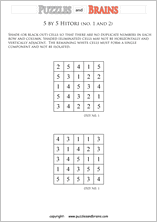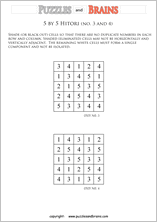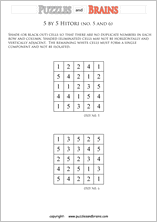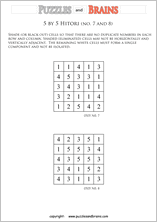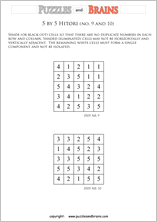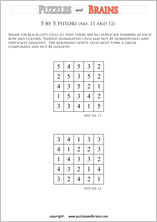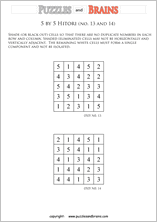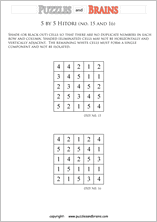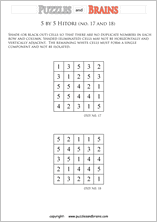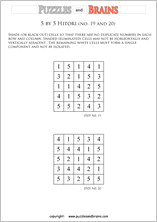Printable Hitori puzzles
At PuzzleAndBrains.com we have tens of printable Hitori logic puzzles for you. We offer printable puzzles in many formats. The rules of Hitori are at the bottom of this page.
The Basic Rules of Hitori
1. No duplicate numbers in rows and columns.
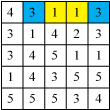 In the first row of this 5 by 5 Hitori puzzle there are 2 duplicate couples: there are 2 ones and 2 threes. This is not possible and we have to shade or black out a one and one three. Which ones? Well that's up to you to figure out (more on that later)
In the first row of this 5 by 5 Hitori puzzle there are 2 duplicate couples: there are 2 ones and 2 threes. This is not possible and we have to shade or black out a one and one three. Which ones? Well that's up to you to figure out (more on that later)
2. Shaded cells may not be horizontally and vertically adjacent.
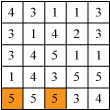 In the last row we find 3 fives. Because shaded or colored (or blacked out) cells may not be horizontally or vertically adjacent, we may not shade the five in the middle. One of the first tactics to solve a Hitori puzzle is to scan for triplets as they make it easy to eliminate the first numbers in the Hitori puzzle.
In the last row we find 3 fives. Because shaded or colored (or blacked out) cells may not be horizontally or vertically adjacent, we may not shade the five in the middle. One of the first tactics to solve a Hitori puzzle is to scan for triplets as they make it easy to eliminate the first numbers in the Hitori puzzle.
3. White cells must form a single component and not be isolated.
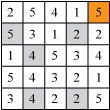 The remaining white cells must form a single component and not be isolated from each other. In the first row we see 2 fives. If we would shade the first 5, the 2 in the left corner would be isolated from the other white cells. We have to shade or color the five in the right corner.
The remaining white cells must form a single component and not be isolated from each other. In the first row we see 2 fives. If we would shade the first 5, the 2 in the left corner would be isolated from the other white cells. We have to shade or color the five in the right corner.
General Solving Strategies for Hitori Puzzles
Many Hitori addicts (lovers) circle the numbers that may or cannot be shaded as a visual aid. Hitori is basically an elimination puzzle, where a cell is shaded or not. Elimination helps you solving the puzzle. Here follow a couple of basic techniques:
Numbers between pairs
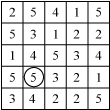 The circled 5 is between a pair of 4's and may not be shaded. Because 1 of the 2 fours needs to be shaded, the 5 cannot. A shaded four and a shaded five would become horizontally adjacent (against rule 2!)
The circled 5 is between a pair of 4's and may not be shaded. Because 1 of the 2 fours needs to be shaded, the 5 cannot. A shaded four and a shaded five would become horizontally adjacent (against rule 2!)
Numbers around a Shaded Number cannot be shaded
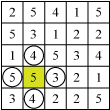 When you have determined that a certain number must be shaded, you can conclude that all numbers around it (horizontally and vertically adjacent) may not be shaded. This is the application of the first rule. If the 5 in this example Hitori is shaded, you may not shade the circled adjacent numbers.
When you have determined that a certain number must be shaded, you can conclude that all numbers around it (horizontally and vertically adjacent) may not be shaded. This is the application of the first rule. If the 5 in this example Hitori is shaded, you may not shade the circled adjacent numbers.
Avoid Isolation
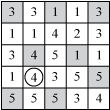 Non shaded numbers cannot be isolated. They form a continuous and single component.
In the 2nd column in this example we have to shade the four in the third place and not the one in the fourth position.
Would we shade the 4 in the fourth position, than the five at the bottom would be a isolated white cell that is not part
of the continuous component.
Non shaded numbers cannot be isolated. They form a continuous and single component.
In the 2nd column in this example we have to shade the four in the third place and not the one in the fourth position.
Would we shade the 4 in the fourth position, than the five at the bottom would be a isolated white cell that is not part
of the continuous component.
 In the first row of this 5 by 5 Hitori puzzle there are 2 duplicate couples: there are 2 ones and 2 threes. This is not possible and we have to shade or black out a one and one three. Which ones? Well that's up to you to figure out (more on that later)
In the first row of this 5 by 5 Hitori puzzle there are 2 duplicate couples: there are 2 ones and 2 threes. This is not possible and we have to shade or black out a one and one three. Which ones? Well that's up to you to figure out (more on that later)
2. Shaded cells may not be horizontally and vertically adjacent.
 In the last row we find 3 fives. Because shaded or colored (or blacked out) cells may not be horizontally or vertically adjacent, we may not shade the five in the middle. One of the first tactics to solve a Hitori puzzle is to scan for triplets as they make it easy to eliminate the first numbers in the Hitori puzzle.
In the last row we find 3 fives. Because shaded or colored (or blacked out) cells may not be horizontally or vertically adjacent, we may not shade the five in the middle. One of the first tactics to solve a Hitori puzzle is to scan for triplets as they make it easy to eliminate the first numbers in the Hitori puzzle.
3. White cells must form a single component and not be isolated.
 The remaining white cells must form a single component and not be isolated from each other. In the first row we see 2 fives. If we would shade the first 5, the 2 in the left corner would be isolated from the other white cells. We have to shade or color the five in the right corner.
The remaining white cells must form a single component and not be isolated from each other. In the first row we see 2 fives. If we would shade the first 5, the 2 in the left corner would be isolated from the other white cells. We have to shade or color the five in the right corner.
General Solving Strategies for Hitori Puzzles
Many Hitori addicts (lovers) circle the numbers that may or cannot be shaded as a visual aid. Hitori is basically an elimination puzzle, where a cell is shaded or not. Elimination helps you solving the puzzle. Here follow a couple of basic techniques:
Numbers between pairs
 The circled 5 is between a pair of 4's and may not be shaded. Because 1 of the 2 fours needs to be shaded, the 5 cannot. A shaded four and a shaded five would become horizontally adjacent (against rule 2!)
The circled 5 is between a pair of 4's and may not be shaded. Because 1 of the 2 fours needs to be shaded, the 5 cannot. A shaded four and a shaded five would become horizontally adjacent (against rule 2!)
Numbers around a Shaded Number cannot be shaded
 When you have determined that a certain number must be shaded, you can conclude that all numbers around it (horizontally and vertically adjacent) may not be shaded. This is the application of the first rule. If the 5 in this example Hitori is shaded, you may not shade the circled adjacent numbers.
When you have determined that a certain number must be shaded, you can conclude that all numbers around it (horizontally and vertically adjacent) may not be shaded. This is the application of the first rule. If the 5 in this example Hitori is shaded, you may not shade the circled adjacent numbers.
Avoid Isolation
 Non shaded numbers cannot be isolated. They form a continuous and single component.
In the 2nd column in this example we have to shade the four in the third place and not the one in the fourth position.
Would we shade the 4 in the fourth position, than the five at the bottom would be a isolated white cell that is not part
of the continuous component.
Non shaded numbers cannot be isolated. They form a continuous and single component.
In the 2nd column in this example we have to shade the four in the third place and not the one in the fourth position.
Would we shade the 4 in the fourth position, than the five at the bottom would be a isolated white cell that is not part
of the continuous component.
Contact us at: contact@puzzlesandbrains.com



